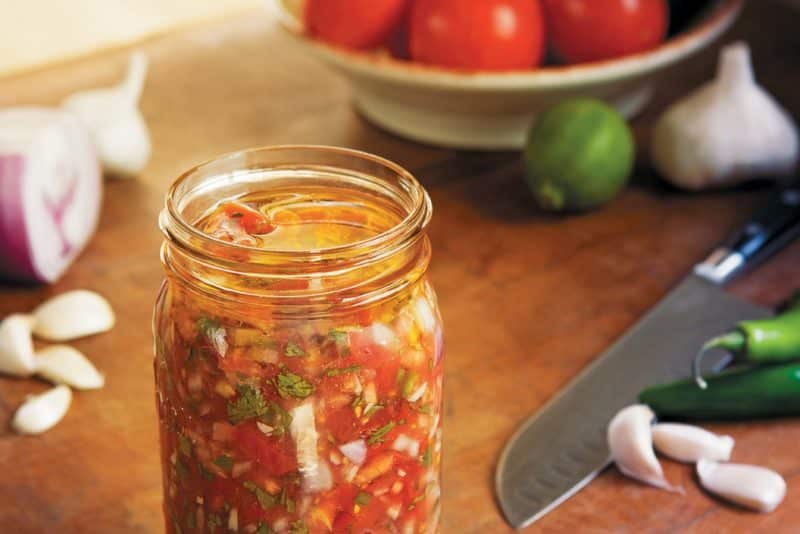Used by permission from The No-Waste Vegetable Cookbook : Recipes and Techniques for Whole Plant Cooking by Linda Ly from Harvard Common Press.
Why fermented salsa? Why not normal salsa like you’ve always made? I’ve used this same recipe for nonfermented salsa and it ’s fine—great, actually—but fermentation pushes it over the line to fantastic.
The same bacteria and yeasts that give sauerkraut and kimchi their distinctive flavor also give this salsa a bright and tangy note. And, those same bacteria and yeasts are what make this salsa so good for your gut. It’s an easy way to get fermented foods in your diet if you’re not keen on kraut; the salsa is lively on the taste buds without being too sour or too salty.
Ingredients
- •1 1/2 pounds (680 g) tomatoes, cut into small dice
- •1/2 red onion, cut into small dice
- •1/2 to 1 jalapeno pepper, minced (some jalapenos are hotter than others, so do a taste test before putting the whole thing in there)
- •1/2 serrano pepper, minced
- •5 garlic cloves, minced
- •1/2 cup (8 g) chopped cilantro
- •1 1/2 teaspoons kosher salt
- •1/2 teaspoon ground cumin
- •Juice of 1 lime
- •Olive oil for topping


Preparation
In a medium bowl, combine all the ingredients (except the oil). Pour the salsa into a quart jar (946 ml) and run a knife around the sides of the jar to release any trapped air bubbles.
Add a 1/2-inch (1.3 cm) layer of oil on top. The oil serves two purposes: It prevents the vegetables from rising above the liquid and growing mold on the surface, and it adds a richness to the salsa once you mix it in.
Loosely seal the jar with a lid and let it stand at room temperature, out of direct sunlight, for a few days. The warmer your room temperature is, the faster your salsa will ferment. You’ll begin to see bubbles in the jar as the lactic acid bacteria flourish. Taste the salsa after 3 to 4 days; if it hasn’t developed a bold, tangy flavor yet, leave it out for up to 1 week. The longer you let it ferment, the more intense the flavor will become, and the longer the salsa will keep (since the bacteria are a natural preservative). Refrigerate once the salsa reaches peak flavor. The oil may congeal in the cold temperature, but it is still safe to eat. Bring the salsa to room temperature and stir in the oil before serving.
EASY DOES IT
Fermented salsa undergoes the same process of lacto-fermentation as sauerkraut (the lacto refers to lactic acid, not lactose). By letting your salsa sit out for a few days, you’ll encourage all kinds of beneficial bacteria in the mix, creating a powerful probiotic that you can’t get enough of (in my house, a jar never lasts more than a couple of days!). Many fermentation recipes call for the addition of whey or starter culture to infuse the food with good bacteria, but this simple recipe requires only the existing bacteria (which are already present on the skins of all your vegetables) to get started. It may take a day or two longer to ferment, but the ease makes it worth the wait.

